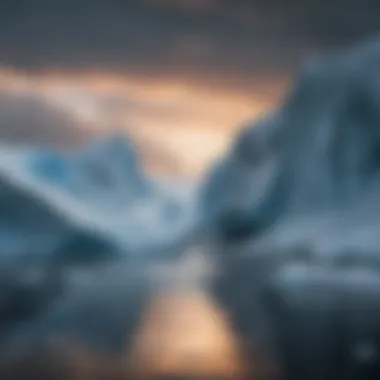Recent Discoveries in Antarctica: A Comprehensive Review


Intro
The exploration of Antarctica has progressed significantly over the past few decades, with discoveries that reshape our understanding of not only the continent itself but also the wider implications for global systems. This unique environment harbors mysteries that hold crucial data about the past, present, and future of our planet. Recent advancements in fields like microbiology, glaciology, paleoclimatology, and geology illuminate essential aspects of climate change and biodiversity.
This article aims to provide a comprehensive review of these discoveries, offering insights that appeal to both experts in the field and those with a general interest in science. Through a detailed analysis of the findings, we can grasp the importance of Antarctica as a barometer for global environmental changes.
Recent Advances
Latest Discoveries
Recent research efforts have unveiled remarkable findings in several scientific domains. In microbiology, scientists have identified extremophiles, microorganisms that thrive in the harsh conditions of Antarctica. These organisms not only showcase the resilience of life but also offer potential applications in biotechnology and medicine.
In glaciology, significant data has been gathered concerning ice sheet dynamics. The Thwaites Glacier, for example, has drawn attention due to its rapid melting and potential impact on global sea levels. Studies indicate that weakening of the glacier's ice shelf is occurring faster than previously thought, raising alarms about the future of coastal regions worldwide.
Paleoclimatology has also made strides. Ice cores extracted from Antarctic glaciers provide invaluable records of past climate conditions. Analysis of these cores reveals fluctuations in temperature and greenhouse gas concentrations, shedding light on how natural processes interact with anthropogenic climate change.
Geological studies contribute yet another layer to our understanding. The unique geological formations of Antarctica offer clues to the continent's tectonic history and its role in past supercontinents. The findings show that the continent has undergone significant transformation, affecting oceanic currents and weather patterns.
Technological Innovations
Technological advancements have propelled the capabilities of researchers operating in Antarctica. Innovations in remote sensing and satellite imagery allow scientists to collect and analyze data over extensive areas. Unmanned aerial vehicles (UAVs) have become a vital tool for monitoring glacial movement and mapping the terrain more accurately than ever before.
Furthermore, improvements in laboratory techniques enable the processing of samples in extreme conditions, ensuring that findings are both accurate and timely. Developments in data storage and transmission are also critical, allowing for more efficient sharing of information among the scientific community.
Methodology
Research Design
The research conducted in Antarctica relies on a collaborative approach, often involving multiple institutions and countries. This synergy allows for a range of experiments and studies that cover various aspects of the Antarctic environment. Long-term projects often incorporate a mix of field studies and laboratory work.
Data Collection Techniques
Data collection in such a remote and harsh environment poses challenges. Scientists use a combination of manual sampling and high-tech equipment to gather information. Techniques such as ice core drilling, sediment sampling, and water column analysis are standard. These methods are essential in obtaining accurate data that reflect the current state of the environment.
"The Antarctic region is not just an isolated continent; it is a key player in the global climate system." - Recent studies emphasize this crucial connection.
In summary, the recent discoveries in Antarctica contribute significantly to our understanding of climate change and its global implications. The ongoing evolution of research methods and technological innovations ensures that new information continues to emerge, enriching our knowledge of this vital region.
Prolusion to Antarctic Exploration
Antarctica, often seen as a remote and inhospitable region, has become a critical focal point for scientific exploration. The icy continent is not just an expanse of snow; it is a treasure trove of ecological and geological secrets. Understanding Antarctica's environment can help scientists make sense of global climate patterns. This section will delve into the historical and current approaches to explore this vast land.
Historical Context
The exploration of Antarctica began in the early 19th century with early expeditions aiming to map uncharted territories. Notable figures such as James Cook and Ernest Shackleton ventured into these frigid regions, laying the groundwork for future explorations. Early findings revealed not only the challenging conditions but also the ecological uniqueness of the continent.
Scientists used these expeditions to collect data on ice formations and weather patterns, which contributed to foundational theories about climate. The historical significance of these expeditions extends beyond mere discovery; they shaped our understanding of how isolated ecosystems can provide clues to global environmental changes.
Current Exploration Initiatives
As we move into the 21st century, current exploration initiatives continue to build on this rich legacy. Modern technology facilitates more detailed and expansive studies. For example, researchers make extensive use of satellite imagery to monitor glacial changes and migrating animal populations.
Collaborative efforts, such as the International Antarctic Scientific Commission, bring together researchers from various countries. Initiatives focus on various themes such as biodiversity, climate change, and the search for microbial life. These efforts not only promote global stewardship of the environment but also enrich scientific knowledge.
Recent projects, like the Antarctic Mid-ocean Ridge project, aim to explore subglacial ecosystems and gather insights that were not previously accessible. Collectively, these activities illustrate the importance of ongoing scientific inquiries in understanding the continent’s role in global ecological balance.
Microbial Discoveries in Antarctica
The exploration of Antarctica offers a unique perspective on microbial life. Understanding these discoveries is critical for several reasons. First, Antarctic microbes exist in extreme conditions. Their adaptations provide significant insights into microbial resilience and survival. This knowledge has implications for astrobiology, as similar conditions may be found on other celestial bodies. Second, Antarctic microbial ecosystems play a vital role in biogeochemical cycles, thus influencing global climate patterns. The investigations into these microorganisms help elucidate their contributions to carbon and nutrient cycling. Finally, these studies address potential applications in biotechnology and environmental science. The next subsections unpack the particularities behind these unique life forms and their essential roles in ecosystem functions.
Unique Microbial Life Forms
Antarctica hosts a diverse array of microbial life. These organisms include bacteria, archaea, viruses, and fungi. One remarkable feature is their ability to thrive in low temperatures, extreme salinity, and high UV radiation levels. Recent studies have isolated novel species, such as Psychrobacter and Chlamydomonas, which reveal unique genetic adaptations. A significant discovery was made with microorganisms found in subglacial lakes, like Lake Vostok. These microorganisms survive without access to sunlight, primarily relying on chemosynthesis. These life forms challenge existing theories on the limits of life and promote ongoing research into their potential applications. The adaptations of these microbes provide clues into biological processes that are critical under extreme environmental conditions.
The Role of Microbes in Ecosystem Function
Microbes in Antarctica contribute significantly to biogeochemical processes. They facilitate nutrient cycling, which supports entire ecosystems. For example, they decompose organic materials, releasing essential nutrients back into the ecosystem. This decomposition process is crucial for supporting larger organisms that rely on microbial breakdown of matter for sustenance.
Microbial communities, although microscopic, underpin the health of entire Antarctic ecosystems. Their activities shape the environment around them.
In addition, certain microbes play a role in carbon fixation. The unique adaptations allow these organisms to sequester carbon effectively, which is increasingly important as global climate change progresses. Understanding their function helps scientists assess potential ecological shifts. The ongoing research on these microbials not only furthers our knowledge of Antarctic environments but also addresses broader ecological questions. Hence, the importance of studying these life forms cannot be overstated.
Glacial Studies and Findings
Glacial studies are vital for understanding both the past and future of our planet. They inform us about climate change and its implications on a global scale. Recent research highlights how glaciers in Antarctica are responding to warming temperatures. This knowledge impacts not only local ecosystems but also sea levels worldwide. The future of Antarctic ice is crucial to our understanding of climate patterns and the health of Earth's systems.
Melting Ice Caps: A Global Concern


Melting ice caps in Antarctica represent one of the most urgent issues related to climate change. The Antarctic ice sheet plays a critical role in regulating Earth's climate. As the planet warms, the ice caps are retreating, leading to increased sea levels.
This phenomenon threatens coastal cities all over the globe. The increase in fresh water from melting ice affects ocean currents, which are essential for global weather patterns. For example, studies show that the West Antarctic Ice Sheet is in a state of instability. If this ice sheet collapses, it could contribute significantly to global sea level rise.
"Understanding the dynamics of melting ice is critical not just for Antarctica but for the entire planet."
The local wildlife, such as penguins and seals, is also affected by the changing environment. Their habitats are shrinking, which adds another layer of ecological concern. To summarize, the melting ice caps are a prominent indicator of climate change that requires urgent attention.
Glacier Dynamics and Their Implications
Glacier dynamics encompass the movements of glaciers and the processes involved in their formation and alteration. Recent studies highlight the complexity of these dynamics. For instance, when glaciers melt, they not only release fresh water but also reveal underlying geological features that have significant implications for our understanding of climate history.
Researchers utilize satellite imagery and ground-based measurements to observe these dynamics in real time. One area of focus is the flow of ice streams, which move rapidly and dictate the overall stability of the ice sheet. Changes in these flows can indicate accelerating melting.
The implications of glacier dynamics are extensive:
- Sea Level Rise: As glaciers shed ice, they contribute consistently to rising sea levels.
- Ecosystem Changes: Alterations in meltwater patterns impact freshwater ecosystems, affecting nutrient distribution.
- Geological Insights: The study of glacier dynamics can provide information about Earth's past climate conditions, shaping future climate models.
Research in this area not only enhances our scientific knowledge but also informs policymakers. Adequate responses to these changes are essential for future environmental management strategies.
Paleoclimatological Insights
Paleoclimatological insights are crucial in understanding Earth's climate history. This knowledge is essential for predicting how climate systems might behave in the future. Studying Antarctica's ice cores provides a window into past climates, illustrating how natural and anthropogenic forces have interacted over time. The implications of this knowledge extend beyond Antarctica, influencing global climate policy and environmental decision-making.
Ice Core Analysis
Ice core analysis is a key technique used in paleoclimatology. Scientists extract cylindrical samples of ice from glaciers and ice sheets. These samples contain trapped air bubbles that preserve ancient atmospheres. By measuring the gas composition and isotopes within these bubbles, researchers can reconstruct past atmospheric conditions. This method has revealed significant data about carbon dioxide levels, temperature fluctuations, and volcanic activity over a wide time span, often covering hundreds of thousands of years.
Recent studies using ice cores from the East Antarctic Ice Sheet have shown that global temperatures were warmer than today during certain periods in the past. These findings are vital as they inform our understanding of natural climate variability. Moreover, they highlight the drastic changes still occurring in our current climate system.
Climate Patterns Unveiled
The analysis of paleoclimate data from Antarctica has unveiled vital climate patterns that shape our understanding of current environmental conditions. For instance, research indicates cyclical climate patterns driven by natural phenomena such as solar activity and ocean currents. These patterns have influenced global weather changes over millennia.
Key observations from recent studies include:
- Sharp fluctuations in temperature during glacial and interglacial periods. These changes reflect the sensitivity of climate systems to external forcings.
- Evidence of past abrupt transitions. This suggests that similar rapid changes could occur again, urging caution regarding our current trajectory of climatic change.
- Linkages between polar and global climates. Findings show how Antarctic conditions can affect weather patterns far beyond the continent.
"Understanding these past climate patterns helps shape predictive models for future climate scenarios."
Geological Discoveries
Geological discoveries in Antarctica play a crucial role in understanding the Earth's history, its climatic changes, and the ongoing processes shaping our planet. The extreme conditions of Antarctica preserve geological records that span millions of years, providing invaluable insights into the evolution of the planet. These discoveries not only contribute to geology but also help in broader environmental science, particularly in understanding climate change and its impacts.
Rock Formations and Geological History
Antarctica is home to diverse rock formations which tell a story about the Earth's past. The continent's geology is predominantly made up of ancient crustal rocks, some of which are over a billion years old. Researchers study these formations to grasp the tectonic history of the region.
Key features include:
- Craton Formation: The East Antarctic Craton, a stable part of the Earth's crust, offers clues about continental drift and plate tectonics.
- Sedimentary Basins: These formations provide evidence of past environments, such as ancient oceans and shallow seas that once covered the land.
- Volcanic Activity: Certain areas, like the Ross Island, show igneous activity, helping scientists understand the geothermal processes at play.
By examining rock samples and formations, researchers can reconstruct past climates and changes in biodiversity. These studies often involve isotopic analysis, which can reveal changes in temperature and atmospheric composition over time.
Mineral Resources and Their Significance
The geological richness of Antarctica also includes various mineral resources, which hold significant implications for both science and industry. While mining is currently restricted under the Antarctic Treaty System, the potential for future resource extraction raises important considerations.
Significant mineral resources include:
- Coal: Found in the Transantarctic Mountains, indicating past lush environments that supported extensive vegetation.
- Oil and Natural Gas: Estimates suggest that the continental shelf may hold substantial reserves, potentially becoming a strategic focus in the future.
- Minerals like Iron and Copper: Valuable in industrial applications, these minerals are essential for modern technology and infrastructure.
The significance of these resources extends beyond mere economic_value. Understanding the distribution and extraction possibilities of these minerals can help researchers assess the environmental impact of resource exploitation.
"Scientific investigations into Antarctica’s geology not only expand our scientific knowledge but also help forecast future environmental shifts."
Antarctic Biodiversity
Antarctic biodiversity is crucial for understanding the ecological framework of one of the harshest environments on Earth. The life forms that thrive here have adapted remarkably to extreme conditions. This section discusses the significance of these species, their evolution, and how they relate to broader environmental issues.
Endemic Species and Their Adaptations
Antarctica is home to diverse endemic species that have evolved adaptations for survival in severe climates. These species include the emperor penguin, Weddell seal, and various types of cold-adapted microorganisms. The adaptations of these life forms can be broken down into several categories:
- Physiological Adaptations: Many animals possess unique abilities to regulate their body temperature and conserve energy. For instance, the emperor penguin has developed a thick layer of insulating feathers, allowing it to withstand freezing temperatures during the harsh winter months.
- Reproductive Strategies: The timing of breeding is crucial in Antarctic species like the Weddell seal. They give birth during the summer when conditions are milder, ensuring that their pups have a better chance of survival.
- Behavioral Adaptations: Many species demonstrate social behaviors that help them cope with the environment. Penguins, for example, huddle together for warmth during severe weather.
These adaptations allow species to thrive in an environment where few can survive. Continued research into these species is essential to understand their role in the ecosystem and recognize how they cope with changes in their environment.


Impacts of Climate Change on Wildlife
Climate change poses significant threats to Antarctic wildlife and their habitats. The consequences of rising temperatures affect ecosystem dynamics in multifaceted ways:
- Habitat Loss: Melting ice due to climate change reduces the natural habitat for species like seals and penguins. Their breeding and feeding grounds are disappearing, impacting their survival rates.
- Changes in Food Supply: The decline of krill populations, which are fundamental to the Antarctic food web, can disrupt the diets of many species, including whales and seabirds. As the marine ecosystem alters, it can lead to a chain reaction affecting various trophic levels.
- Behavioral Changes: Wildlife may adjust their migration patterns and breeding cycles in response to temperature shifts. These changes can lead to mismatches in the timing between predator and prey.
"The interplay between climate change and wildlife in Antarctica offers critical insights into the resilience of species and the need for urgent conservation efforts."
Understanding these impacts is vital for developing effective conservation strategies. Protecting Antarctic biodiversity is not just about preserving these species but also ensuring the overall health of the planet's ecosystems.
Future of Antarctic Research
Antarctica continues to offer rich opportunities for scientific inquiry. The future of research in this region holds promise for unearthing new knowledge critical for understanding changes in climate and ecosystems. As climate change remains a pressing global challenge, research initiatives aimed at Antarctica will help shed light on broader environmental patterns. This section outlines emerging technologies and collaborative efforts which are fundamentally reshaping the landscape of Antarctic research.
Emerging Technologies in Research
Technology is advancing rapidly, facilitating unprecedented research opportunities in Antarctica. Innovations like remote sensing and unmanned aerial vehicles are becoming integral in collecting data efficiently. Remote sensing, for instance, provides vast amounts of information about ice thickness, snow cover, and surface temperatures without needing physical access to sites.
Recently, the development of satellite technologies is allowing scientists to monitor changes over time. Tools such as NASA's Ice, Cloud, and land Elevation Satellite (ICESat-2) have improved the precision of satellite measurements. Additionally, the use of drones enables researchers to access hard-to-reach areas, conducting surveys and capturing images for analysis.
The integration of technology not only increases the efficiency of research efforts but also enhances safety, reducing potential risks associated with fieldwork in extreme conditions.
Furthermore, advancements in data analytics, including machine learning, play a critical role in interpreting complex datasets. This allows for more accurate modeling of climate impacts and better predictions of future changes, aiding in the formulation of policies relating to climate action and conservation efforts.
Collaborative International Efforts
Collaboration among countries is pivotal for Antarctic research due to the geopolitical sensitivity of the region. The Antarctic Treaty System, which sets the framework for international governance, supports scientific cooperation. This treaty encourages nations to work together, fostering an environment of shared knowledge and resources.
Recent projects have demonstrated the power of partnership. Initiatives such as the International Collaboration for Antarctic Research (ICAR) unite researchers from various disciplines and countries. Such collaboration enables diverse perspectives to inform research practices and broadens the impact of findings.
Additionally, international databases are being established to facilitate data sharing. This increases accessibility to research findings and enhances our collective capacity to study critical issues like climate change and its impact on Antarctic ecosystems. When countries pool resources and expertise, they amplify the potential for groundbreaking discoveries.
Conservation Efforts in Antarctica
Conservation in Antarctica is vital not only for preserving its unique ecosystems but also for maintaining the planet's overall health. As climate change progresses, the impact on this pristine environment is more pronounced. Conservation efforts aim to mitigate risks, protecting both the land and the diverse species that inhabit it.
One of the various challenges involves a mix of international governance and local strategies.
Protective Policies and Agreements
Several protective policies and agreements have been established to govern activities in Antarctica. The Antarctic Treaty System, signed in 1959, is the cornerstone of these initiatives. It ensures that Antarctica is used exclusively for peaceful purposes and scientific research. This treaty facilitates collaboration among nations and develops guidelines that minimize human impact on the ecosystem.
Additionally, the Protocol on Environmental Protection to the Antarctic Treaty, also known as the Madrid Protocol, outlines specific measures for conservation. This includes a comprehensive approach to environmental impact assessments and bans on mining, ensuring that exploitation does not compromise the delicate balance of the Antarctic ecosystem.
Moreover, The Convention for the Conservation of Antarctic Marine Living Resources focuses on protecting the marine biodiversity surrounding the continent. These established frameworks provide a basis for sustainable practices, reinforcing the commitment to preserving Antarctica's ecological integrity.
Challenges in Conservation Implementation
Despite existing protective measures, there are notable challenges in their implementation. One of the primary issues is balancing research activities with conservation goals. Research often requires establishing temporary bases and undertaking activities that can inadvertently disrupt local habitats.
Additionally, the growing influence of climate change adds another layer of complexity. Melting ice and changing weather patterns affect not only the wildlife but also the areas designated for research. Continuous monitoring and adaptation of policies are necessary to keep pace with these changes.
Moreover, enforcement of regulations can be inconsistent due to the remoteness of the region and the various nations involved. Varying interpretations of regulations can lead to discrepancies in how conservation policies are applied.
"Protecting Antarctica involves more than just policy—it requires a commitment from the global community to cooperate and adapt to ongoing challenges."
In summary, while significant policies exist to safeguard Antarctica, the practical challenges in implementing those policies remain critical for ensuring the long-term sustainability of this unique environment. Understanding these elements will inform more robust and effective conservation strategies for the future.
The Role of Satellite Technology
The role of satellite technology in Antarctic research cannot be understated. It offers unparalleled advantages in observing and understanding this remote and harsh environment. The technology allows researchers to collect data over large areas quickly and efficiently. This capability leads to more comprehensive studies, especially where on-ground observations may be solely limited due to extreme weather conditions and accessibility issues. Furthermore, satellite data enhances the accuracy of climate models, providing essential information regarding climate change and its global implications.
Remote Sensing in Climate Studies
Remote sensing has become a cornerstone for climate studies in Antarctica. Satellite imagery enables scientists to monitor the dynamics of ice sheets, glaciers, and changing landforms. NASA's MODIS (Moderate Resolution Imaging Spectroradiometer) is one example. It can capture images of large regions in various spectra, aiding in the analysis of surface temperature changes over time.
This method provides valuable insights into:
- Ice melting patterns: Scientists can track how fast glaciers are retreating.
- Sea ice extent: Quantifying the seasonal changes in sea ice helps understand habitat shifts for marine life.
- Temperature fluctuations: Remote sensing offers a broad view of warming trends across the Antarctic continent.
- Ecosystem stability: By monitoring vegetation and microbial colonies, researchers can gauge ecosystem health.
These advancements aid in predicting future climatic conditions more accurately, highlighting the integral role of Antarctic satellite technology in studying global climate trends.
Mapping and Monitoring Changes
Mapping is another critical aspect of satellite technology, especially in preventing the loss of crucial historical data due to climate change. Satellite mapping provides high-resolution images that are crucial in capturing geographical and geomorphological variations over time. Sentinel-1, a twin satellite system from the European Space Agency, utilizes radar technology to monitor movements within the Antarctic ice sheets. This is pivotal because it allows scientists to assess shifts and gain insights into glacial dynamics.


The benefits include:
- Monitoring land-use changes: Helps evaluate the impacts of melting ice on land and marine ecosystems.
- Disaster preparedness: Accurate mapping offers crucial data in predicting potential natural hazards, benefiting both researchers and local communities.
- Data integration: Satellite maps can be combined with other geographical information systems (GIS) to enhance understanding of complex environmental processes.
"Satellite technology transforms our ability to study Antarctic climate change effectively, providing layers of data that deepen our understanding of this unique ecosystem."
Integrating satellite technology into Antarctic research not only expands our knowledge but also fosters international collaborations. Alignment between various global entities can lead to efficient data sharing and better-informed decision-making. The continued evolution of satellite technology is indisputably vital to advancing our understanding of Antarctic conditions and their broader implications.
Key Takeaways from Recent Research
Recent research in Antarctica has led to various notable findings with significant implications, particularly in relation to climate policy and educational opportunities. This section highlights the critical points that emerge from these discoveries, specifically the relationship between Antarctic research and global environmental policies, as well as the broader lessons for future generations.
Implications for Global Climate Policy
The research outcomes from Antarctica provide essential insights into climate change. Antarctica plays a crucial role in the Earth's climate system. The melting ice sheets and glaciers contribute to rising sea levels, which affect coastal communities worldwide. Understanding these dynamics through recent studies enables policymakers to formulate more informed climate policies.
Moreover, the data gathered from ice core samples reveals historical climate trends, allowing scientists to project future changes. These projections are fundamental for global climate initiatives, such as the Paris Agreement, as they offer a clearer picture of the urgent need for action.
In this context, insights into the resilience of Antarctic ecosystems, which are subject to extreme conditions, offer lessons on adaptation strategies. The following are critical takeaways regarding climate policy:
- Rising Sea Levels: Evidence shows that the Antarctic region is a significant contributor to global sea level rise.
- Historical Data: Ice cores can reveal past climate conditions, thus helping to predict future scenarios.
- Ecosystem Dynamics: Observations of how species adapt can inform conservation strategies globally.
"Antarctica's research serves not only as a scientific frontier but also as a moral compass for global action against climate change."
Lessons for Future Generations
The findings from Antarctica serve as a powerful reminder of the fragility of our planet. They carry important lessons for young people who will inherit the environmental challenges we face. Education and awareness derived from this research play a vital role in shaping future leaders and informed citizens.
Educational programs, based on Antarctic discoveries, emphasize the importance of scientific inquiry and critical thinking. They encourage students to take a keen interest in environmental science and policy. Here’s what can be imparted to future generations:
- Understanding Biodiversity: Learners can learn about unique species and their adaptations, fostering appreciation for biodiversity.
- Scientific Literacy: Exposure to advanced research methods can inspire future scientists.
- Global Citizenship: As stewards of the Earth, students should be encouraged to partake in discussions about climate ethics and responsibilities.
In summary, the key takeaways from recent Antarctic research underscore the profound interconnections between this remote region and global environmental challenges. These impacts are not solely academic but resonate with implications for policy, education, and stewardship, enlightening the path forward for the next generation.
Societal Impact of Antarctic Discoveries
The exploration of Antarctica has implications that reach far beyond its icy borders. Understanding the societal impact of discoveries made in this region is crucial. These findings inform global discussions on climate change, biodiversity, and resource management.
Most importantly, Antarctic studies foster a greater awareness of environmental issues. With reports showing alarming trends in ice melt and species endangerment, the urgency for public engagement rises. Knowledge gained from this unique environment directly influences policies and behaviors. Thus, increased awareness can motivate communities worldwide to take action in combating climate change.
Awareness and Public Engagement
One of the primary societal effects of Antarctic discoveries is enhanced public awareness. Findings from Antarctica often make headlines, but the depth of this knowledge is not always explored. The media plays a significant role in translating complex scientific data into more digestible content for the general public. Interactive platforms, such as social media, have become essential tools in this process.
People are more likely to engage with issues that they feel a part of. Highlighting Antarctica as a barometer for global climate health helps the public relate to distant impacts. Examples include harsh impacts on communities as a result of changing sea levels. As scientific knowledge advances, educational campaigns can tailor information to different audiences. The overall goal is to create a more informed electorate who can advocate for necessary change in legislation.
"No single region encapsulates climate change as vividly as Antarctica. Its threats are unignorable; the knowledge unearthed here holds the key to our future."
Educational Opportunities through Research
The discoveries in Antarctica usher in a wealth of educational opportunities. Scientific initiatives inspire students, researchers, and educators alike. Schools can integrate current Antarctic research into curriculums. This leads to student engagement in important global issues at an early age.
Research from Antarctica presents an expanding horizon for academic inquiry. For example, projects focused on microbial life in the harsh environment might intrigue biology students. They can explore survival mechanisms, which bridge topics from biochemistry to ecology.
Additionally, students of multiple disciplines could evaluate human impacts on the environment through project-based learning. Partnerships with universities, research institutions, and non-governmental organizations can further enrich this educational framework.
Some key aspects of educational opportunities in Antarctic research include:
- Undergraduate and Graduate Programs: Many institutions offer courses focusing on polar science, which can lead to specialized career paths.
- Fieldwork Experience: Students can participate in expeditions, gaining firsthand experience in harsh conditions.
- Publications and Presentations: Engaging in research increases the likelihood of publishing papers or presenting findings at conferences.
Overall, the societal impacts of Antarctic discoveries extend beyond simple scientific knowledge. They have the potential to reshape educational priorities and public consciousness.
The End
The conclusion of this comprehensive review is pivotal in summarizing the extensive findings related to recent discoveries in Antarctica. As the exploration of this frozen continent sheds light on numerous scientific fields, the insights gathered have profound implications both locally and globally.
Summation of Findings
Through in-depth studies of microbial life, climatic shifts, and geological changes, researchers have unveiled critical data.
- Microbial Discoveries: Insights into unique microbial life forms show how these organisms adapt to extreme conditions. They play an essential role in nutrient cycling and indicate the potential for life in harsh environments elsewhere.
- Glacial Studies: The alarming rates of ice melt contribute to sea level rise, impacting global ecosystems. Identifying glacier dynamics helps in predicting future climate scenarios.
- Paleoclimatology: Analysis of ice cores reveals historical climate patterns, offering context for current changes. This data is vital for developing effective global climate policies.
- Geological Findings: The unique geological history of Antarctica provides clues about Earth’s past. Understanding these formations is crucial for comprehending present geological processes.
"Discoveries in Antarctica not only enrich our understanding of this unique ecosystem but also serve as a crucial reflection on the state of our planet's health and future."
Through these findings, it becomes clear that the research conducted in this region is not simply about Antarctica itself; it relates to broader environmental issues that affect all of humanity.
Future Directions for Exploration
Looking ahead, the future of Antarctic exploration appears promising yet demands stringent focus. Key considerations include:
- Technological Advancements: The integration of advanced technologies, such as AI and robotics, will facilitate deeper exploration in areas that are difficult to access. These tools can provide valuable data on climatic conditions and geological stability.
- Collaborative Research Initiatives: Strengthening international partnerships will be vital. Collaborative efforts enable multidisciplinary approaches to complex issues like climate change and biodiversity loss.
- Sustainable Practices: As exploration continues, so too does the need for sustainable practices. Protecting Antarctica's delicate ecosystems while conducting research is fundamental.
- Increased Awareness: Educating the public and policymakers about the significance of Antarctic studies is necessary to foster support for conservation measures and policy implementations.
Antarctic research has reached a critical juncture where it can profoundly influence scientific understanding and environmental policy. The path forward requires an innovative spirit and collaborative framework to grasp the intricacies of this unique environment.















